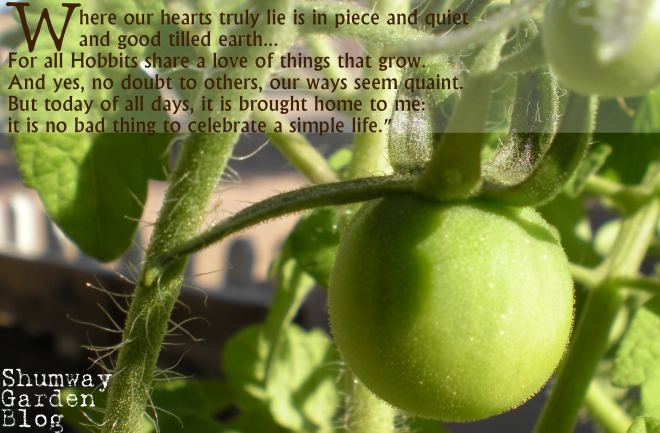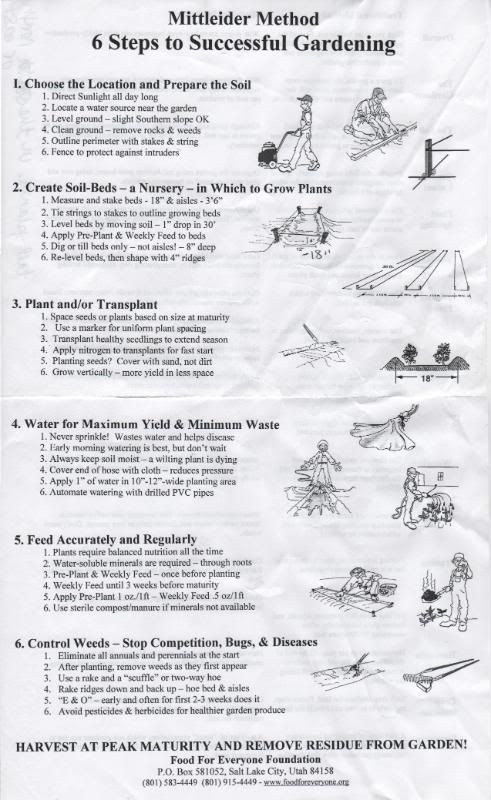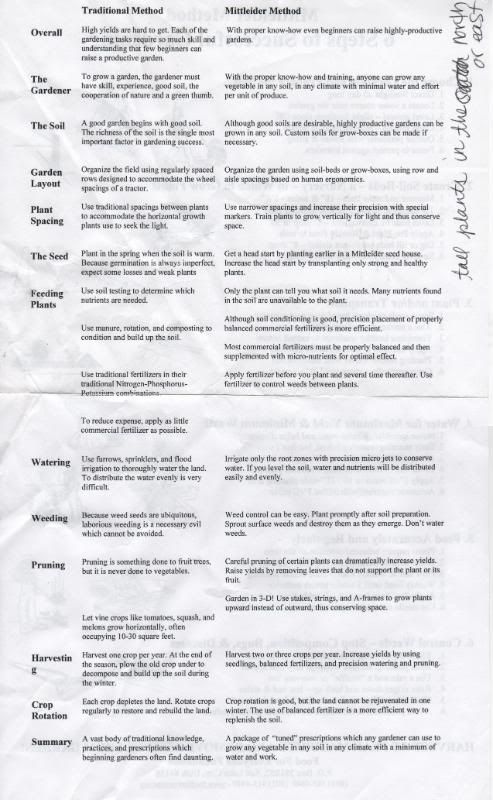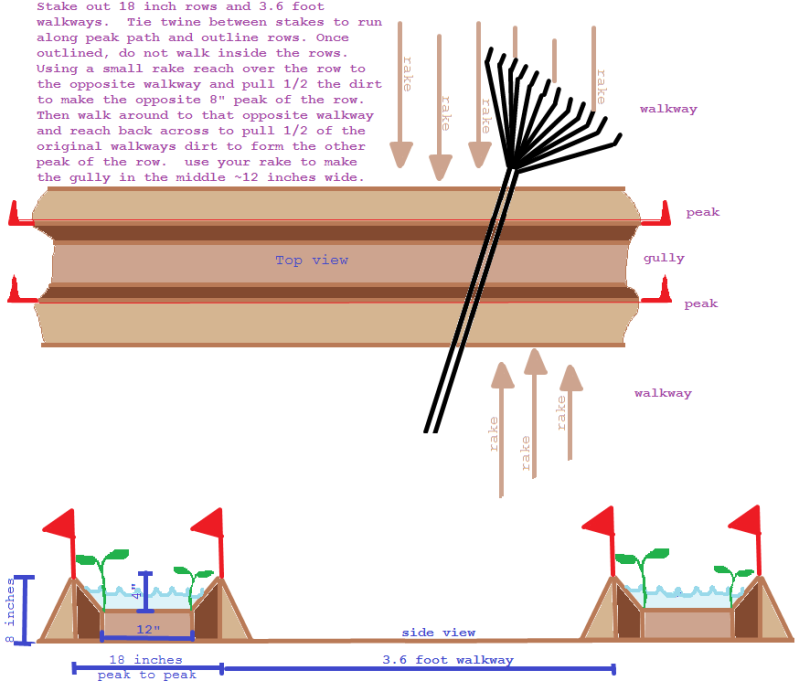
Sunday, November 1, 2009
How to make rows!

Saturday, October 31, 2009
How to Transplant

Saturday, June 20, 2009
7-week progress




Hey y'all! These are pictures from my 7 week progress. sorry I'm posting this so late- I took these pics and videos right before girls camp so didn't post them and then I got home on the 13th, took pictures again and didnt post them because I have been exhausted cleaning, getting dental work done (yes, I know, when will it end?), and a ton of other stuff. I had a sleeping bag stolen off of my porch by the way (I left the camping stuff out there and have been gradually putting things away. grr.
Tuesday, June 2, 2009
6-week Progress and Garlic!
Also, I dug our garlic up, braided the roots together and hung it to dry! I'm sad that I only harvested 2 of them- the others I had to dig up and transplant to pots to make room for the garden in April and I wasn't able to save them- the larger of these two was transplanted and did alright but I had three die on me :o( I ripped too many roots. I can't wait to plant some more in October! What fun!



Sunday, May 24, 2009
Tuesday, May 19, 2009
4-week progress
If you haven't read about the garden, please see
GARDENING WITH MITTLEIDER part I
GARDENING WITH MITTLEIDER part II
GARDENING WITH MITTLEIDER part III
Wednesday, May 13, 2009
I CANT...STOP...EATING....
 This is a serious problem..... I have these tomatoes ripening left and right and they are soooo good. I'm actually quite surprised I love them so much because I'm not really a tomato person. and definitely not a cherry tomato person. I hate the feeling of the tomato bursting in your mouth. yuck. I do not like tomatoes in salad, but I do like a good tomato sliced thick with salt and pepper. mmmmm. these are perfect for that (even though they are small) they are so yummy with a little s&p. yay for the first veggies yielded from my delectable garden.
This is a serious problem..... I have these tomatoes ripening left and right and they are soooo good. I'm actually quite surprised I love them so much because I'm not really a tomato person. and definitely not a cherry tomato person. I hate the feeling of the tomato bursting in your mouth. yuck. I do not like tomatoes in salad, but I do like a good tomato sliced thick with salt and pepper. mmmmm. these are perfect for that (even though they are small) they are so yummy with a little s&p. yay for the first veggies yielded from my delectable garden.
Tuesday, May 12, 2009
3-WEEK Progress
If you haven't read about the garden, please see
GARDENING WITH MITTLEIDER part I
GARDENING WITH MITTLEIDER part II
GARDENING WITH MITTLEIDER part III
Sunday, May 10, 2009
Gardening with Mittleider part III
GARDENING WITH MITTLEIDER part I
GARDENING WITH MITTLEIDER part II

- by the way, Matthew has his own small shovel now :o)
I have the rest of the initial videos downloaded and so here is part III: (while some of these things seem simple to a lot of us, not everyone here has even picked up a shovel, so, there you go.)
So sorry about the tutu folks. Welcome to my life :o)
This one is really dark, SO sorry!
So basically just wrap the end of a dishtowel around the end of your hose and rubberband it in place. Lay the towel-hose at the end of the row between the peaks, turn the water on low and let it seep out to fill up the row 1" deep full of water. I water mine every morning so they are watered and ready to face the HEAT! 105 degrees today! I need to get my shade cloth! (we will talk about this soon)
Tuesday, April 28, 2009
Gardening with Mittleider part II
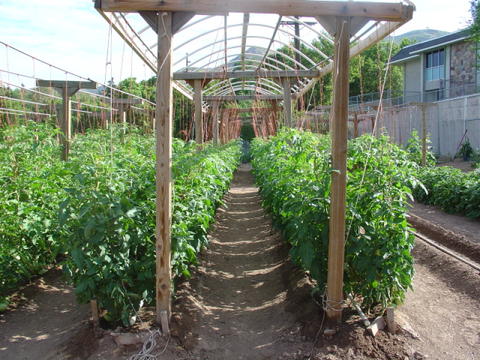
Hey everyone- oh my goodness these videos are a bear to upload!! I have been trying to do them at night so that we can use the computer during the day, but sometimes they're not done in the morning so we've had to cancel the almost done uploads several times. bleh. I thought I'd post the first four vids and a few tips up to that point and then on part III I'll continue to give tips and show videos. My plants have been in for a week and a half now and actually started sprouting 2 days after. I love Arizona!

Control 6 Elements for Success:
1. Light
Your plants must have full sunlight all day long! No trees, shrubs, fences. Plants can even shade themselves. Prune off excess sucker stems so there is plenty of air and light.
2. Temperature
Seed usually don't germinate until they reach 75-80 degrees. If your climate is a cold one, you can build a mini frame around your rows and cover it with greenhouse plastic (uv protected). If your climate is too hot, use the same frame but cover it with 30% white shade cloth (30% is maximum- you can go lower). And only cover in the hottest parts of the day. Plants will stop fruiting once the temperature reaches 95 degrees.
3. Air
Plants receive air through the roots- they need soil air. No standing water, so avoid flooding. Make your beds 2 inches above the height of the walk ways to promote drainage.
4. Water
A plant is a continuous water pipe from the tip of the smallest root to the top of the highest leaf.
If you have a problem with salinity (salt) in the soil, create the beds, then flood it three times and it will get the salt far enough down away from the planting area that your plants wont be affected.
It is important to have level beds so that all nutrients given to the plants will stay and soak into the soil where they are placed, rather than running to the lowest point of the bed when watered. (I have a video of how to level the beds coming soon)
Water only the root zone of the plant. *Do not sprinkle* this will water weeds, waste water and promote disease. Try your hardest to not get the rest of the plant wet when you water- this just promotes disease as mentioned. If you automate water using an above the ground drip system it will be easier, faster, and more efficient. Using 3/4 inch #200 psi pvc piping (painted with exterior paint) and drill 3 #57bit holes every 4 inches. Set this on a 6"long 2x4 to suspend above root zone. (when I make mine I will video and post)
A plant can not grow beyond it's most limiting factor. In my opinion food is, in most cases, the most limiting factor. There are plenty of the nutrients that your plant needs in most soil, however, many are bonded to other elements and cannot be absorbed by the roots, so they do you no good. The food given to plants must be water soluble and available to roots. The 13 natural mineral nutrients needed for the best growth and health of the plant are:
- Nitrogen
- Phosphorus
- Potassium in the form of Potash
Plants use these nutrients to develop different parts; N builds strong leaves, Phosphate builds strong roots, and Potash promotes root development and disease resistance.
- Calcium
- Sulfur (Ca and Sulfur are found in gypsum)
- Magnesium (epsom Salt)
- Zinc
- Boron
- Manganese
- Iron
- Copper
- Chloride
- Molybdenum
Weed early and often. do not use mulch. keep ground dry and bare.
Preplant mix
ok, I actually said the wrong amount to apply on this video- it's 2Tbs per square foot. The weekly feed is 1 Tbs per running square foot. Sorry about that! Just mix up a bunch and share your left overs with your neighbors! That's what I've been doing!
Friday, April 17, 2009
Gardening with Mittleider part I

In Papua New Guinea they were having problems with cannibalism. Whenever a tribal war was won, the winning tribe would eat the losing tribe. People were getting Creutzfeldt-Jakob disease (the human version of mad-cow disease-allegedly contracted from eating the brains of a member your species) which causes dimentia, speech impairment, jerky movements (myoclonus), balance and coordination dysfunction (ataxia), changes in gait, rigid posture, and seizures. Usually people will die within weeks to months of getting it and there is no known cure. The Australian military came in and put a stop to the cannibalism, but then the people needed a new primary source of food. They sustained their tribes on sweet potatoes, but not well. In the area that Jacob Mittleider visited, the hospital and school were about to be shut down because they couldn't feed the people the necessary 5lbs of potatoes per day. After Mittleider came and showed them how to garden his way, their sweet potatoes were 5 times as large as they used to be and were grown quicker and so yeilded more crops per year. They were able to sell and barter their sweet potatoes and thrived as farmers. One boy who was taught this method, Sir Silas Atopare, grew to become President of Papua New Guinea from 1997-2003.
AMAZING???? I know!
So, with that being said, I am going to continue into my first installment of "Gardening with Mittleider." At the free seminar, we were given a handout that I will share with you about how the rows are supposed to look and how this method differs from traditional gardening.
If you want me to email you these notes so they're easier to read, just let me know. Also, if you click on them they will become a tiny bit larger.
Here is a little bit about the Method from Jim Kennard:
Here is my garden planning vid:
Sorry about that weird little bit about the Frankenstein corn dog. I'm such a freak.
PS- If you're a gardener, here is a Gardening Journal from FFE foundation you might appreciate
GARDENING WITH MITTLEIDER part II
GARDENING WITH MITTLEIDER part III
Saturday, February 28, 2009
Garden Tour
Since then.....
My tomato and pepper plants are twice as big as they are in the movie and it's only a week later!
My mixed greens have grown and I cleaned up all the dead leaves- looks a little more appetizing, eh?




